Panamax
Authors: Gil d'Orey, Nuno Bizarro Sentieiro, Paolo Soledade
Publisherer: Heidelberger Spieleverlag/Mesaboardgames
Year: 2014
review by

| x |
|
|
|
|
|
|
|
|
|
|
|
|
|
|
|
|
|
|
|
|
|
|
|
|
|
|
|
|
|
|
|
|
|
|
|
|
|
|
|
|
|
|
|
|
|
|
|
|
|
|
|
|
|
|
|
|
|
|
|
|
|
|
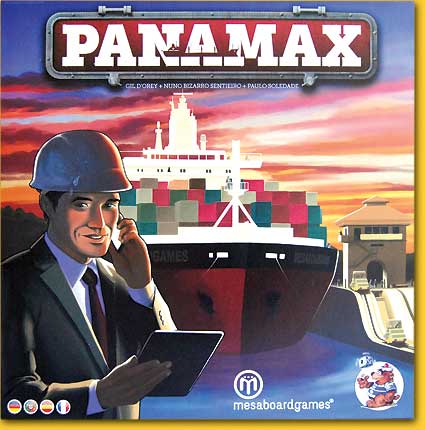 |
The Panama Canal was opened in 1914. It enabled ships traveling between the Atlantic and Pacific Oceans to avoid the treacherous Cape Horn route below South America. Over the years ships have gotten larger and larger, and not all of them fit through the canal. The largest size ships that can still traverse the canal are called Panamax. |
|
|
|
| x |
|
|
|
|
|
|
|
|
|
|
|
|
|
|
|
|
|
|
|
|
|
|
|
|
|
|
|
|
|
|
|
|
|
|
|
|
|
|
|
|
|
|
|
|
|
|
|
|
|
|
|
|
|
|
|
|
|
|
|
|
|
|
| In Panamax every player controls a shipping company with some starting capital and some cargo ships, and everyone starts with one share of their own company and some private funds. Just like in 18xx-games the company funds and the private funds are kept strictly separate. Obviously the Panama Canal is prominently shown on the game board: two entries (on one side for ships from China and the US West Coast, on the other side for European and East Coast ships), a number of locks and two lakes. At both entry points several ships are waiting for their cargo. |
|
|
|
| x |
|
|
|
|
|
|
|
|
|
|
|
|
|
|
|
|
|
|
|
|
|
|
|
|
|
|
|
|
|
|
|
|
|
|
|
|
|
|
|
|
|
|
|
|
|
|
|
|
|
|
|
|
|
|
|
|
|
|
|
|
|
|
 |
| x |
|
|
|
|
|
|
|
|
|
|
|
|
|
|
|
|
|
|
|
|
|
|
|
|
|
|
|
|
|
|
|
|
|
|
|
|
|
|
|
|
|
|
|
|
|
|
|
|
|
|
|
|
|
|
|
|
|
|
|
|
|
|
|
At the start of each round a number of dice are rolled to determine the available actions. Then in player order each player chooses a die and performs the corresponding action, until every player has performed four actions. There are basically three kinds of actions: moving ships (by choosing a die with value 1 to 3), loading ships (value 4 to 6), or the director’s action, which is only possible with a limited number of dice; this allows you to use your private funds to buy a share in a company (your own or an opponent’s) or increase your own share price with two.
|
|
|
|
| x |
|
|
|
|
|
|
|
|
|
|
|
|
|
|
|
|
|
|
|
|
|
|
|
|
|
|
|
|
|
|
|
|
|
|
|
|
|
|
|
|
|
|
|
|
|
|
|
|
|
|
|
|
|
|
|
|
|
|
|
|
|
|
 |
|
|
|
| x |
|
|
|
|
|
|
|
|
|
|
|
|
|
|
|
|
|
|
|
|
|
|
|
|
|
|
|
|
|
|
|
|
|
|
|
|
|
|
|
|
|
|
|
|
|
|
|
|
|
|
|
|
|
|
|
|
|
|
|
|
|
|
| When loading the player takes the cargo card next to the selected die. This cards depicts a flag and between 1 and 3 containers with a value varying from 1 to 6. The player covers these containers with dice in his own color turned to the corresponding side. Then he may load a number of dice onto the waiting ships, but he has to this in the same zone as the flag depicted on the card: dice being loaded from a card with a European flag have to end up on a ship in the European zone. A very interesting rule is that during one action only one die can be loaded on each ship. So you can forget about filling your own large ship in one go! A lot of times you will also have to load your cargo onto your opponents’ ships and/or one of the neutral ships. Sometimes on the cargo card a railroad track symbol is depicted next to a container: that die then has to be loaded onto the train rather than a ship. |
|
|
|
|
|
|
|
|
|
|
|
|
|
|
|
|
|
|
|
|
|
|
|
|
|
|
|
|
|
|
|
|
|
|
|
|
|
|
|
|
|
|
|
|
|
|
|
|
|
|
|
|
|
|
|
|
|
|
|
|
|
|
|
|
|
|
 |
|
|
|
|
|
|
|
|
|
|
|
|
|
|
|
|
|
|
|
|
|
|
|
|
|
|
|
|
|
|
|
|
|
|
|
|
|
|
|
|
|
|
|
|
|
|
|
|
|
|
|
|
|
|
|
|
|
|
|
|
|
|
|
|
| Every time someone manages to empty one of their cargo cards they take a corresponding flag marker. These are kept on their company board and can unlock all kinds of advantages, such as free movement or the possibility to buy a share. The player taking a cargo card can also choose to turn it to the other side. The back side generally depicts less containers and no flag. This makes it easier to load the dice (as the loading zone restriction is gone) but doesn’t earn any flag markers when emptied. |
|
|
|
| xx |
|
|
|
|
|
|
|
|
|
|
|
|
|
|
|
|
|
|
|
|
|
|
|
|
|
|
|
|
|
|
|
|
|
|
|
|
|
|
|
|
|
|
|
|
|
|
|
|
|
|
|
|
|
|
|
|
|
|
|
|
|
|
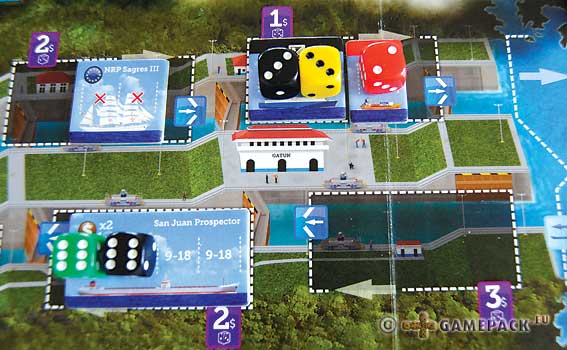 |
|
| x |
|
|
|
|
|
|
|
|
|
|
|
|
|
|
|
|
|
|
|
|
|
|
|
|
|
|
|
|
|
|
|
|
|
|
|
|
|
|
|
|
|
|
|
|
|
|
|
|
|
|
|
|
|
|
|
|
|
|
|
|
|
|
| When moving ships the player can perform 1 to 3 lock movements and 1 to 3 waterway movements, depending on the selected die. The movements can be divided across multiple ships, including those belonging to other companies. This can also result in waiting ships entering the canal (assuming they have meet their minimum cargo requirement). The movement is a most charming mechanism: a large part of the canal consists of locks with a maximum capacity of 4, meaning they can contain one ship of size 4, one of size 3 and a 1, etcetera. Whenever multiple ships are together in the same lock they automatically form a group, and from that point on they can only be moved as a group until they enter a lake or leave the canal. Also, when a ship or group of ships wants to enter a lock when there isn’t sufficient room, they automatically ‘push’ forward the ships currently in that lock. This can cause a chain reaction where you can move a lot of ships with just 1 movement point! There are also military ships that take no cargo but can be moved, earning the moving player as much private funds as the amount of corresponding flag markers he owns. When a loaded ship leaves the canal on the other side the rewards are given out: the dice on the ship pay out their value to the company of their color, and the owner of the ship (not necessarily the same person as the owner of the cargo) gets an advantage card or additional private funds. The advantage cards allow for additional movement points, discount on the cargo fees at the end of the round or a possible bonus at the end of the game. |
|
|
|
| x |
|
|
|
|
|
|
|
|
|
|
|
|
|
|
|
|
|
|
|
|
|
|
|
|
|
|
|
|
|
|
|
|
|
|
|
|
|
|
|
|
|
|
|
|
|
|
|
|
|
|
|
|
|
|
|
|
|
|
|
|
|
|
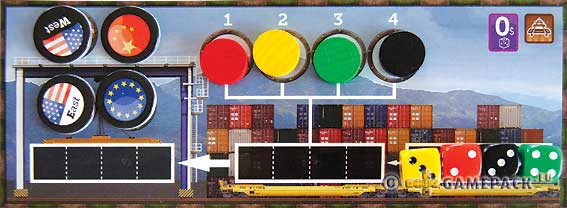 |
After the action phase there are some administrative tasks at the end of the round. First the new player order is determined by the amount of cargo on the train, and every player who has loaded at least one die onto the train gets a flag marker. |
|
|
|
| x |
|
|
|
|
|
|
|
|
|
|
|
|
|
|
|
|
|
|
|
|
|
|
|
|
|
|
|
|
|
|
|
|
|
|
|
|
|
|
|
|
|
|
|
|
|
|
|
|
|
|
|
|
|
|
|
|
|
|
|
|
|
|
| Then the cargo fees have to be paid: depending on where the dice are located every company needs to cough up between zero to five cash per die. If the company does not have sufficient funds the player has to use his private funds to make up the difference, taking one or more loans if necessary. These loans need to be repaid at the end of the game at a hefty interest rate. |
|
|
|
| x |
|
|
|
|
|
|
|
|
|
|
|
|
|
|
|
|
|
|
|
|
|
|
|
|
|
|
|
|
|
|
|
|
|
|
|
|
|
|
|
|
|
|
|
|
|
|
|
|
|
|
|
|
|
|
|
|
|
|
|
|
|
|
 |
|
| x |
|
|
|
|
|
|
|
|
|
|
|
|
|
|
|
|
|
|
|
|
|
|
|
|
|
|
|
|
|
|
|
|
|
|
|
|
|
|
|
|
|
|
|
|
|
|
|
|
|
|
|
|
|
|
|
|
|
|
|
|
|
|
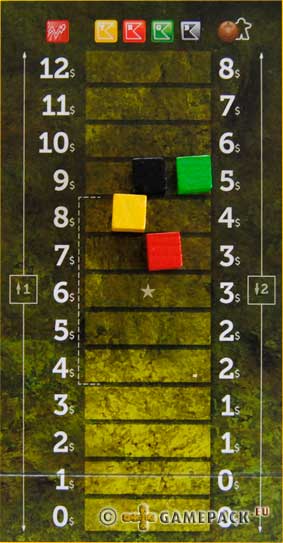 |
Then every company has to pay out dividends if possible, the amount of dividend being dependent on the share price. The higher the share price, the higher the dividends per share. The dividends are added to the shareholder’s private funds. If a company is unable to fully pay the dividends their share price decreases by two. The owner of the company with the highest share price, presuming that company did pay out dividends this round, gets the director award (which is worth extra points at the end of the game), and then the new round can begin. |
|
|
|
| x |
|
|
|
|
|
|
|
|
|
|
|
|
|
|
|
|
|
|
|
|
|
|
|
|
|
|
|
|
|
|
|
|
|
|
|
|
|
|
|
|
|
|
|
|
|
|
|
|
|
|
|
|
|
|
|
|
|
|
|
|
|
|
| After three rounds the game ends. All the company funds are irrelevant for victory! The private funds, supplemented by the value of the owned shares and where applicable bonuses from cards and director awards determine the victor. |
|
|
|
| x |
|
|
|
| x |
|
|
|
| x |
|
|
|
 |
|
|
|
|
|
|
|
|
|
|
|
|
|
|
|
|
|
|
|
|
|
|
|
|
|
|
|
|
|
|
|
|
|
|
|
|
|
|
|
|
|
|
|
|
|
|
|
|
|
|
|
|
|
| Panamax does not really draw you in visually. A heap of dice that are not rolled but just lay on ships that slowly move about, the ‘tiddlywinks’-money, all in all it has a very dry look in spite of the large body of water depicted. That same dry feeling sometimes emerges when playing. Putting dice onto the cargo card, from there onto the ship, and then guide the ship through the entire canal: you have to go through a lot of steps before finally being rewarded. |
|
|
|
| x |
|
|
|
|
|
|
|
|
|
|
|
|
|
|
|
|
|
|
|
|
|
|
|
|
|
|
|
|
|
|
|
|
|
|
|
|
|
|
|
|
|
|
|
|
|
|
|
|
|
|
|
|
|
|
|
|
|
|
|
|
|
|
 |
|
| x |
|
|
|
|
|
|
|
|
|
|
|
|
|
|
|
|
|
|
|
|
|
|
|
|
|
|
|
|
|
|
|
|
|
|
|
|
|
|
|
|
|
|
|
|
|
|
|
|
|
|
|
|
|
|
|
|
|
|
|
|
|
|
Where Panamax shines however, is the great interaction between the players that it offers. This is especially apparent in the loading and movement of the ships. Even if you would manage to load your own ship with three of your own dice, good luck moving that ship through the canal by yourself! If we have a ship owned by player A containing dice from player B and C, each of them has an interest in moving that ship. “And if I take you with me into the lock, then you can(/have to) take me along when you move in your turn!” It is a lot of fun to create all kinds of incentives for your opponents to do things that are (also) for your benefit..
The possibility to buy each other’s shares also creates all kinds of fun considerations. If you own black shares it might be in your interest to ensure those black dice reach their goal. |
|
|
|
| x |
|
|
|
|
|
|
|
|
|
|
|
|
|
|
|
|
|
|
|
|
|
|
|
|
|
|
|
|
|
|
|
|
|
|
|
|
|
|
|
|
|
|
|
|
|
|
|
|
|
|
|
|
|
|
|
|
|
|
|
|
|
|
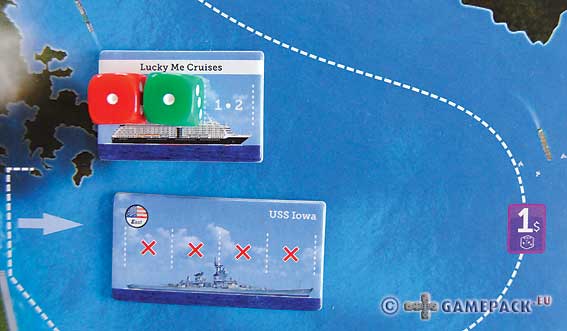 |
|
|
|
| x |
|
|
|
|
|
|
|
|
|
|
|
|
|
|
|
|
|
|
|
|
|
|
|
|
|
|
|
|
|
|
|
|
|
|
|
|
|
|
|
|
|
|
|
|
|
|
|
|
|
|
|
|
|
|
|
|
|
|
|
|
|
|
But do I want black to pay dividends, increasing my private funds? Or not, so their share price drops and I can take the director award? But then my black shares will be worth less…! The many layers of interaction and consideration more than make up for the rough parts in the gameplay.
© 2015 Ugur Donmez
Panamax, Gil d'Orey, Nuno Bizarro Sentieiro, Paolo Soledade, Heidelberger Spieleverlag, Mesaboardgames, 2014 - 2 to 4 players 12 years and up, 100 minutes
|
|
|
|
  |
|
|
|
|
|
|
|
|
|
|
|
|
|
|
|
|
|
|
|
|
|
|
|
|
|
|
|
|
|
|
|
|
|
|
|
|
|
|
|
|
|
|
|
|
|
|
|
|
|
|
|
|
|
  |
Long, tough, unnecessarily complex and confusing. There is almost no joy of playing. |
  |
|
|
|
|
|
|
|
|
|
|
|
|
|
|
|
|
|
|
|
|
|
  |
|
|
|
|
|
|
|
|
|
|
|
|
|
|
|
|
|
|
|
|
|
|
|
|
|
|
|
|
|
|
|
|
|
|
|
|
|
|
|
|
|
|
|
|
|
|
|
|
|
|
|
|
|
| x |
|
|
|
|
|
|
|
|
|
|
|
|
|
|
|
|
|
|
|
|
|
|
|
|
|
|
|
|
|
|
|
|
|
|
|
|
|
|
|
|
|
|
|
|
|
|
|
|
|
|
|
|
|
|
|
|
|
|
|
|
|
|
| x |
|
|
|
|
|
|
|
|
|
|
|
|
|
|
|
|
|
|
|
|
|
|
|
|
|
|
|
|
|
|
|
|
|
|
|
|
|
|
|
|
|
|
|
|
|
|
|
|
|
|
|
|
|
|
|
|
|
|
|
|
|
|
 |
|
|
|
|
|
|
|
|
|
|
|
|
|
|
|
|
|
|
|
|
|
|
|
|
|
|
|
|
|
|
|
|
|
|
|
|
|
|
|
|
|
|
|
|
|
|
|
|
|
|
|
|
|
 |
|
|
|
|
|
|
|
|
|
|
|
|
|
|
|
|
|
|
|
|
|
|
|
|
|
|
|
|
|
|
|
|
|
|
|
|
|
|
|
|
|
|
|
|
|
|
|
|
|
|
|
|
|
| x |
|
|
|
|
|
|
|
|
|
|
|
|
|
|
|
|
|
|
|
|
|
|
|
|
|
|
|
|
|
|
|
|
|
|
|
|
|
|
|
|
|
|
|
|
|
|
|
|
|
|
|
|
|
|
|
|
|
|
|
|
|
|
 |
|
|
|
|
|
|
|
|
|
|
|
|
|
|
|
|
|
|
|
|
|
|
|
|
|
|
|
|
|
|
|
|
|
|
|
|
|
|
|
|
|
|
|
 |
|
|
|
|
|
|
|
|
|
|
|
|
|
|
|
|
|
|
|
|
|
|
|
|
|
|
|
|
|
|
|
|
|
|
|
|
|
|
|
|
|
|
|